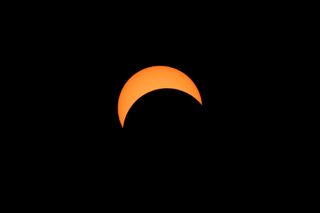

These events then repeat in reverse order: First, the Sun's chromosphere reappears just before totality ends. It is only visible for a few seconds right after totality. The Sun's chromosphere: The second most outer layer of the Sun’s atmosphere gives out a reddish glow.They are little bead-like blobs of light at the edge of the Moon created by the sunlight passing through gaps in the mountains and valleys on the Moon's surface. Baily's beads: About five seconds before totality, Baily's beads appear.It is visible as a faint ring of rays surrounding the silhouetted Moon and is around 200–300 times hotter than the Sun’s surface-its temperature can reach over 1 million ☌ (1.8 million ☏). The Sun's corona: As the diamond ring fades, the outermost part of the Sun's atmosphere becomes more prominent.Together with the single jewel of light from the Sun, it creates the well-known diamond ring effect. Diamond ring: Seen about 10 to 15 seconds before and after totality, the solar corona (the outer atmosphere of the Sun) becomes visible.These shadow bands are the result of Earth’s turbulent atmosphere refracting the last rays of sunlight. Shadow bands: About a minute before totality, moving, wavy lines of alternating light and dark can be seen on the ground and along walls.They appear in this order as totality sets in (and in reverse order as totality ends):

Some sights are only visible during a total solar eclipse. Phenomena only visible near the totality. Make sure you know how long totality lasts in your location. Even a small amount of direct sunlight can damage your eyes. Do not look at the Sun with naked eyes unless the Moon blocks the entire Sun. It is also safe to observe totality through cameras, telescopes, or binoculars without any special filters. It is safe to view a fully eclipsed Sun, totality, with the naked eye. To safely watch a solar eclipse, wear protective eclipse glasses or project an image of the eclipsed Sun using a pinhole projector. The Sun’s radiation can burn your eye's retinas and cause permanent damage or even blindness. Never look directly at the Sun, eclipsed or otherwise, without proper protective eyewear.
#Sun corona in day light images explained full#
Only viewers located in the path of the Moon's full shadow, its umbra, can see a total solar eclipse. Partial solar eclipse on October 25, 2022: Watch it LIVE! Not Total Everywhere In partial and annular solar eclipses, the Moon blocks only a part of the Sun. Business Date to Date (exclude holidays)ĭuring a total eclipse of the Sun, the Moon covers the entire disk of the Sun.


 0 kommentar(er)
0 kommentar(er)
